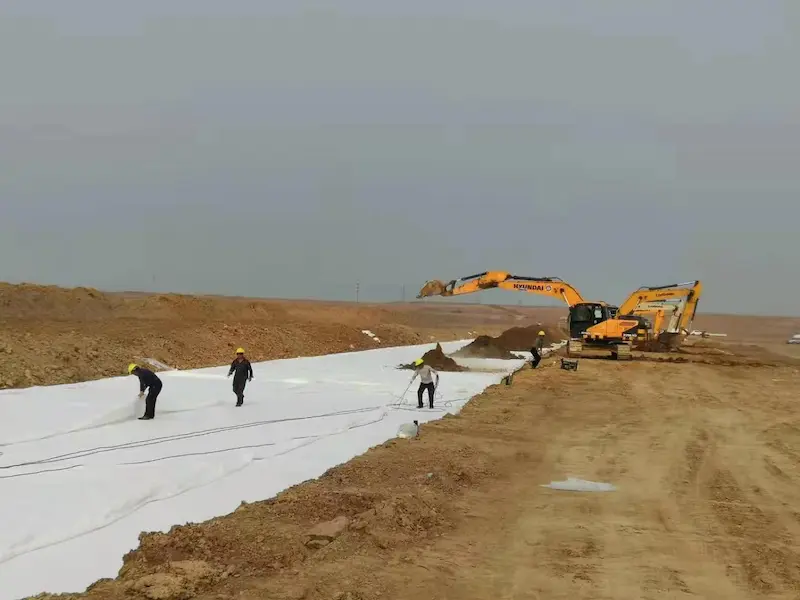What is biodegradable geotextile?
Biodegradable geotextile is a geosynthetic material that can be degraded by microorganisms in the natural environment. It is mainly used in environmental protection and ecological engineering. The use of biodegradable geotextile aims to reduce the impact of plastic waste on the environment and promote sustainable development.
1.Materials and characteristics of biodegradable geotextile
1.1.Materials:
Polylactic acid (PLA): a bioplastic made from renewable resources such as corn starch or sugarcane, with good biodegradability.
Polyhydroxyalkanoate (PHA): a bioplastic produced by microbial fermentation, which is completely biodegradable.
Starch-based composite materials: starch is the main component, and other biodegradable polymers are added to improve material performance and degradation rate.
1.2.Characteristics:
Complete biodegradability: under specific environmental conditions, such as soil or compost environment, it can be completely degraded into carbon dioxide, water and organic matter by microorganisms.
Environmentally friendly: reducing the generation of plastic waste and pollution to the environment, and contributing to ecological environmental protection.
Renewable resources: using natural renewable resources as raw materials, it is sustainable.
Diverse performance: by adjusting the material formula and processing technology, different mechanical properties and functional requirements can be achieved.
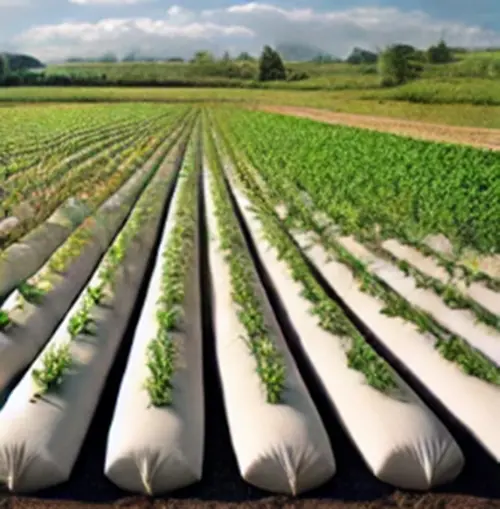
2.Application fields of biodegradable geotextiles
2.1.Ecological restoration and protection:
Vegetation restoration: used for vegetation restoration and protection, the geotextile provides nutrients after degradation, which helps vegetation growth.
Riverbank restoration: used in riverbank and wetland restoration projects to prevent soil erosion and promote ecological balance.
2.2.Agricultural engineering:
Farmland covering: used for farmland covering, providing moisture retention, heat preservation, and weed prevention functions, and no pollution to the soil after degradation.
Drainage system: used in agricultural drainage systems, providing drainage and filtration functions, and will not cause long-term impact on farmland after degradation.
2.3.Landscaping:
Greening projects: used for urban greening and landscape projects, geotextiles will not burden the environment after degradation.
Slope protection projects: used in slope protection projects to prevent soil erosion and promote vegetation growth.
2.4.Construction projects:
Short-term engineering protection: used for protection of temporary construction projects, naturally degraded after the project is completed, leaving no residue.
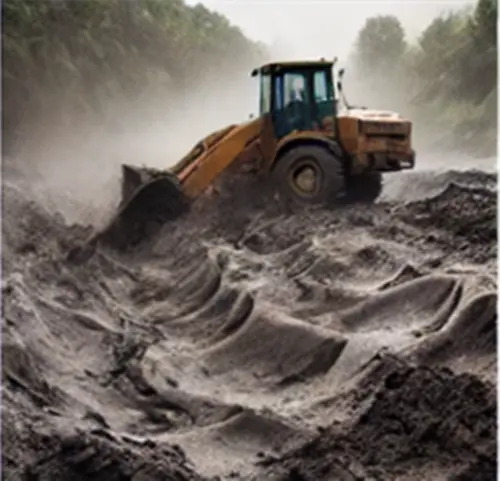
3.Application cases of biodegradable geotextiles
The cases of biodegradable geotextiles in practical applications can show its effects and advantages in different fields. Here are some specific application cases:
3.1. Vegetation restoration project
Case: Kubuqi Desert Management in Inner Mongolia
Background: Kubuqi Desert is the seventh largest desert in China and faces serious land desertification problems.
Solution: Use biodegradable geotextiles to cover sand dunes, fix sand and plant drought-resistant vegetation on them.
Effect: Biodegradable geotextiles provide good fixation and protection. After vegetation grows, the geotextiles degrade naturally, which is harmless to the environment and significantly improves the vegetation coverage rate in the desert.
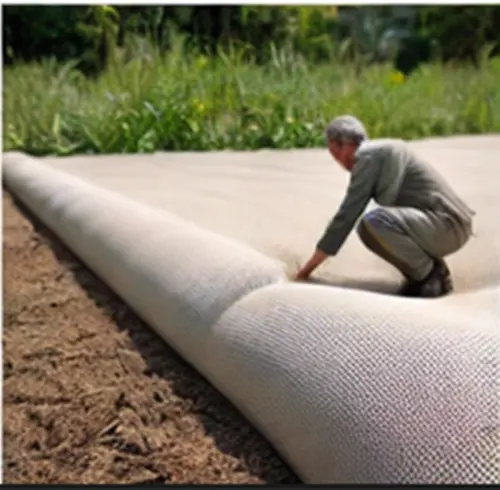
3.2. Farmland coverage and protection
Case: Xinjiang cotton planting
Background: The climate in Xinjiang is dry, and soil moisture retention and weed control are key issues in cotton planting.
Solution: Use biodegradable geotextiles to cover farmland, maintain soil moisture and inhibit weed growth.
Effect: Cotton yield and quality are significantly improved. After degradation, the geotextiles become organic fertilizers, which improve soil structure and fertility.
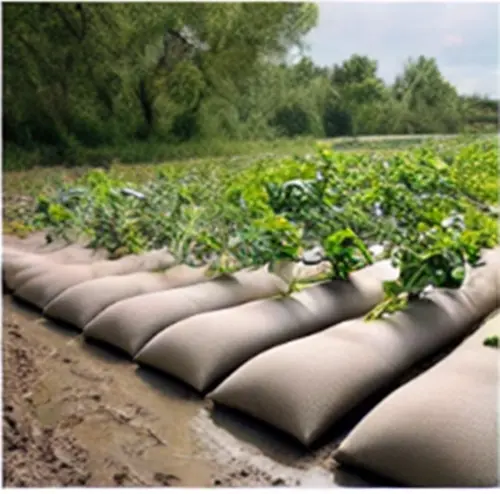
3.3. Riverbank restoration project
Case: River regulation in Zhejiang Province
Background: A river in Zhejiang Province has suffered serious riverbank erosion due to water scouring, affecting the stability of the river and the ecological environment.
Solution: During the riverbank restoration process, biodegradable geotextiles are laid and vegetation is restored.
Effect: Geotextiles provide temporary protection to prevent erosion; after vegetation grows, the geotextiles degrade, and the riverbank stability and ecological environment are effectively improved.
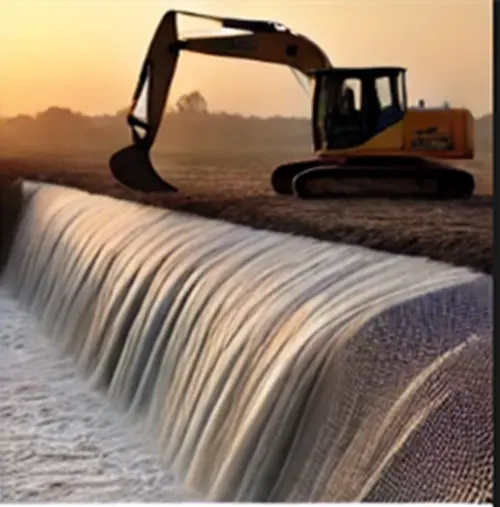
3.4. Landscape greening project
Case: Shanghai City Park Greening
Background: A certain city park needs to be greened on a large scale to improve the urban environment and the quality of life of residents.
Solution: In the greening construction, biodegradable geotextiles are used for ground covering and vegetation planting.
Effect: Plants grow rapidly, and the geotextiles degrade into soil organic matter. The greening effect is long-lasting and environmentally friendly.
3.5. Mine ecological restoration
Case: Reclamation of a mine in Shandong
Background: After the mining is completed, a large number of exposed mining areas are left, which need to be restored ecologically.
Solution: During the mine reclamation process, biodegradable geotextiles are laid and vegetation is planted on them.
Effect: Geotextile effectively prevents soil erosion, and the vegetation coverage rate gradually increases. After the geotextile is degraded, the ecological environment in the mining area is significantly improved.
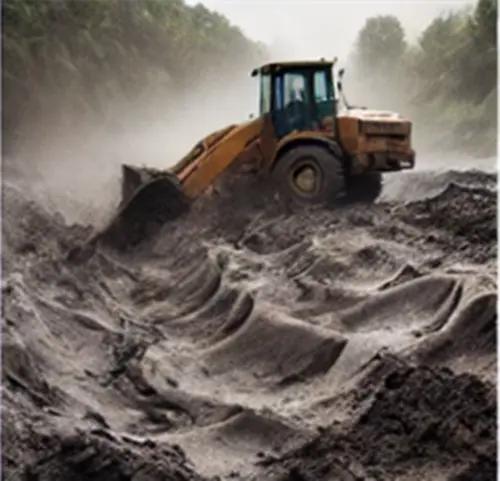
3.6. Road construction protection
Case: Highway construction in mountainous areas of Sichuan
Background: During the construction of mountainous roads, the roadbed and slopes need to be effectively protected to prevent soil and water loss.
Solution: In the construction of roadbed and slopes, biodegradable geotextiles are used for protection.
Effect: Geotextiles provide a stable protective effect. After the construction is completed, the geotextiles are degraded without leaving any residue, and the ecological environment is protected.
3.7.Summary
The actual application cases of biodegradable geotextiles in different fields demonstrate their versatility and environmental advantages. Through these cases, it can be seen that biodegradable geotextiles have played an important role in vegetation restoration, farmland protection, riverbank restoration, landscaping, mine reclamation and road construction. With the continuous development and promotion of technology, biodegradable geotextiles will provide efficient and environmentally friendly solutions for more engineering projects.
4. Advantages and disadvantages of biodegradable geotextiles
4.1.Advantages:
4.1.1.Environmental protection: Completely degraded into harmless substances, will not cause secondary pollution.
4.1.2.Renewable: The raw materials are widely available and renewable, reducing dependence on petrochemical resources.
4.1.3.Versatile: The material formula and performance can be adjusted according to different needs to meet diverse application scenarios.
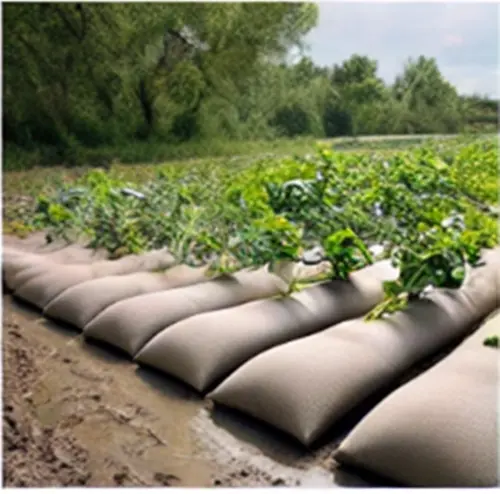
4.2.Disadvantages:
4.2.1.High cost: The production cost of biodegradable materials is usually higher than that of traditional plastic materials.
Polylacticacid (PLA): PLA is a commonly used biodegradable material, usually made from plant resources such as corn starch or sugarcane. The price of PLA is usually more expensive than traditional polypropylene (PP), with a price of about $3-5 per kilogram, but the actual price may vary due to market fluctuations.
Comparison of PLA material prices:
No. | Items | Unit | Price($) |
1 | PLA Staple Fiber
| KG | 3.5-5.0 |
2 | PLA Yarn
| KG | 8-10 |
3 | PLA Granules Extrusion Grade | KG | 2.5-3.5 |
4 | Pbat PLA for Disposable Shopping Grocery Bag | KG | 1.5-1.8 |
Note:The above data is from Made in China. | |||
Polyhydroxyalkanoate (PHA): PHA is a biodegradable material produced by microbial fermentation, and the price is usually higher than PLA, which may be $20-50 per kilogram or even higher.
Other biodegradable materials: There are other biodegradable materials such as polycaprolactone (PCL), and the price of these materials may also be higher, depending on the production and market conditions of the materials.
4.2.2Performance limitations: The mechanical properties of some biodegradable materials may not be as good as traditional plastics, and further optimization and improvement are needed.
4.2.3.Degradation condition requirements: The biodegradation process requires specific environmental conditions, such as appropriate temperature, humidity and microbial environment.
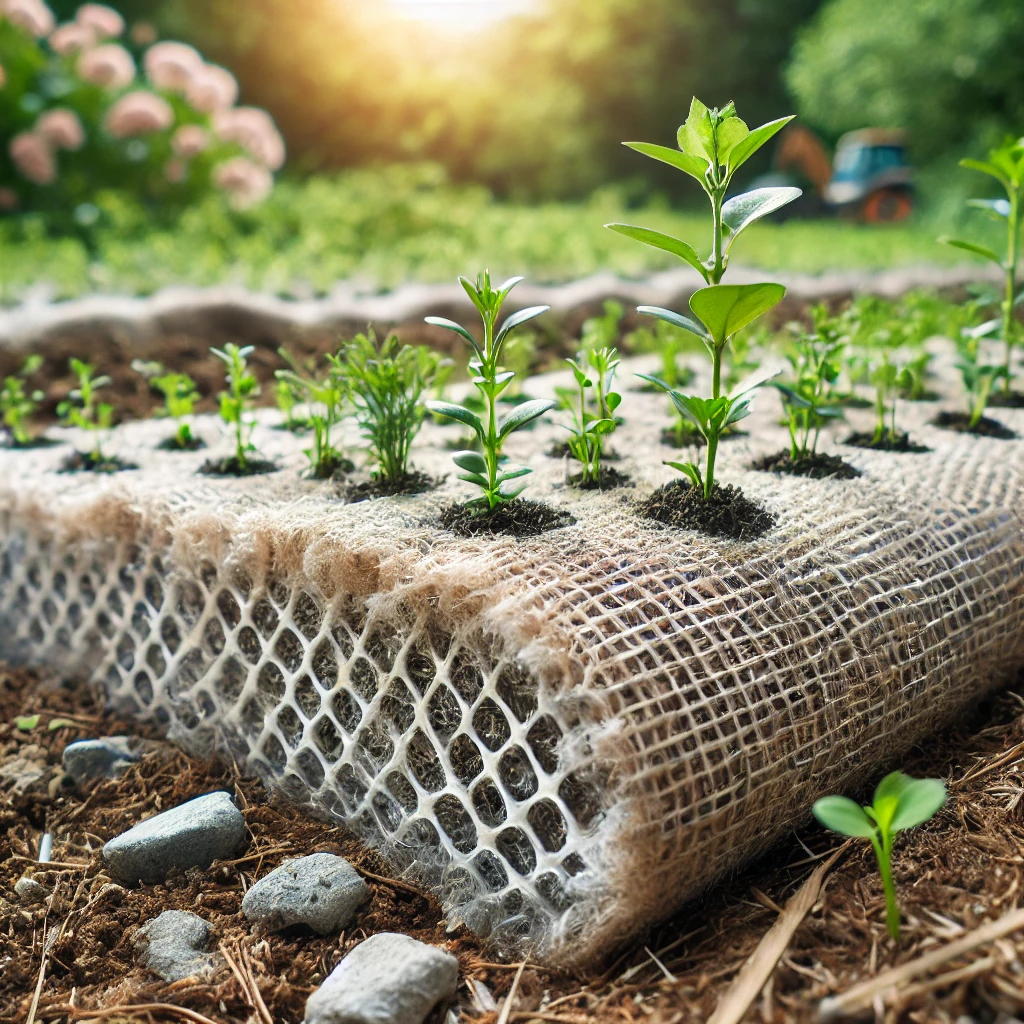
(This is an image of a biodegradable geotextile being used in a natural setting. The image shows a geotextile made from natural fibers, partially buried in soil, being used in a landscape restoration project. Surrounding it are growing seedlings and vegetation, indicating its use in soil stabilization and preventing erosion. The background is a tranquil outdoor setting filled with green and natural elements. This image shows the practical application of biodegradable geotextiles in ecological and environmental engineering.)
5.Summary
As a new type of environmentally friendly material, biodegradable geotextile has broad application prospects in ecological restoration, agricultural engineering, landscaping and construction engineering. With the continuous advancement of technology and the improvement of material performance, biodegradable geotextile will play an important role in more fields and promote sustainable development and environmental protection.Haoyang Environmental Co., Ltd. is a company specializing in the production of geotextiles. If you have any demand for geotextiles, please contact:
Email: sale2@hygeosynthetics.com
Tel: +8616615773081


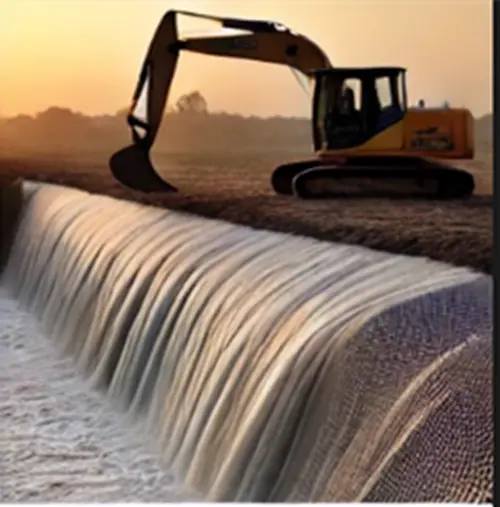
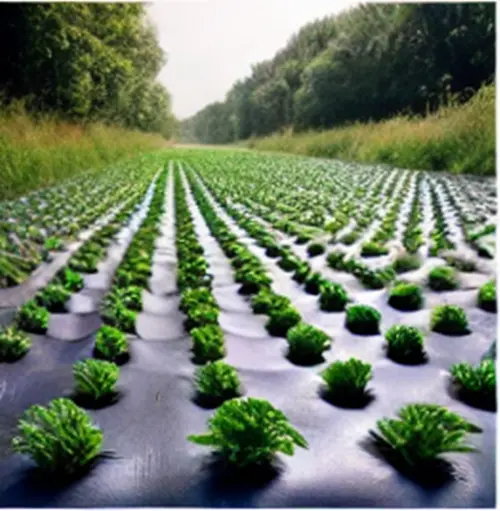
503.webp)
759.webp)
628.webp)
